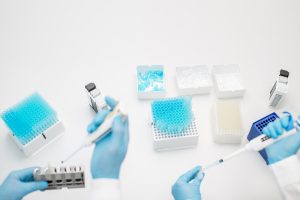
What is your current professional role?
I am the lead electrical engineer on a project at DEKA Research and Development, a small medical device company based out of Manchester, New Hampshire. I was drawn to DEKA after my interest in the medical device field was sparked following years working in industry right out of my undergraduate studies.
What problem were you trying to solve?
This project was imagined in conjunction with Alexis Lowe, a PhD candidate working under Nitish Thakor, a professor in Johns Hopkins Department of Biomedical Engineering. I met Alexis when she was the teaching assistant for one of my online courses. She is working with rat models and was interested in the fairly new paradigm of wireless electromyography (EMG). EMG is a technique for detecting nervous system signals in muscles and is typically done with electrodes implanted in the muscles of the subject, with a long cable connected to a data-collection device. Wireless EMG, as the name suggests, has no tether cable, and allows the animal to roam freely, while still providing data to be transmitted to the wireless receiver. There are currently no commercial off the shelf (COTS) test platforms available that are capable of wireless EMG data collection and video footage collection: most are very expensive and lack test fixtures that are configurable. This inspired me to design a reimagined EMG.
What was your solution?
I designed and built the WREATH, which stands for Wireless Rodent EMG And Tracking Habitat. It’s a new test platform for rat models using low-cost components and it’s designed as an open-source commodity that allows anybody to build the platform on their own. Critically, the WREATH is modular, which means that the “test chamber”—the part of the platform where the rats are placed and perform their activities—can be removed from the data collection shell and swapped with a different test chamber. In this way, a single data collection shell can support any number of test chambers. This allows one platform to work for multiple experimental setups, ultimately reducing long-term costs and saving on lab real-estate and overhead. The WREATH’s data-collection shell has inbuilt cameras that can be positioned almost anywhere around the test chamber module, and footage is captured and saved on an onboard computer. This onboard computer can also make electrical connections to the swappable test modules, allowing the modules to be moderately sophisticated in terms of being powered, having computerized controls, and allowing for automatic collection of other data, where applicable (e.g., running wheel speed). The WREATH also has features that allow for certain wireless EMG receiver platforms to be connected for synchronized data collection.
Why is this work important?
The hope is that this open-source platform, with a growing library of test chamber designs, will be a low-cost and functional test platform that can be adopted by all labs. I view accessibility and fresh perspectives as the lifeblood of progress, and I think it’s a shame any time a budding scientist must cancel a proposed study simply because they lack access to the proper equipment. In the future I hope all labs will have access to functional, low-cost test equipment like WREATH.
What are your next steps regarding the project?
There are a few small things planned for the future of the WREATH. Since graduating in December 2022, I have continued to make progress. I have been creating additional test modules for WREATH, each of which increases its value by expanding its capabilities. I also presented a methods paper on the WREATH at the IEEE/EMBS NER 2023 conference, and hope it will increase awareness of the platform. If the project gains enough traction to merit further development, I have a list of upgrades I would make to a WREATH 2.0 variant, based upon the problems I ran into during the development of the current model.
Why did you choose Johns Hopkins Engineering?
Johns Hopkins University is world renowned in a variety of fields, with the biomedical engineering program being top ranked. That alone was enough to make me interested in applying. However, the fact that Johns Hopkins also offered an online, part-time master’s degree in applied biomedical engineering was the detail that sold me on the institution. Being able to pursue a graduate education and work alongside some of the brightest and most acclaimed researchers in their field, all while working full-time from several states away, was an incredible opportunity. I am extremely grateful for my Hopkins education. Since graduating, I have continued to collaborate with many researchers at Johns Hopkins while further developing WREATH and pursuing other academic endeavors. I enjoy the work that we do and want to continue to make connections and find opportunities in this space. It is my goal to pursue a PhD and to continue my work in the medical device field.